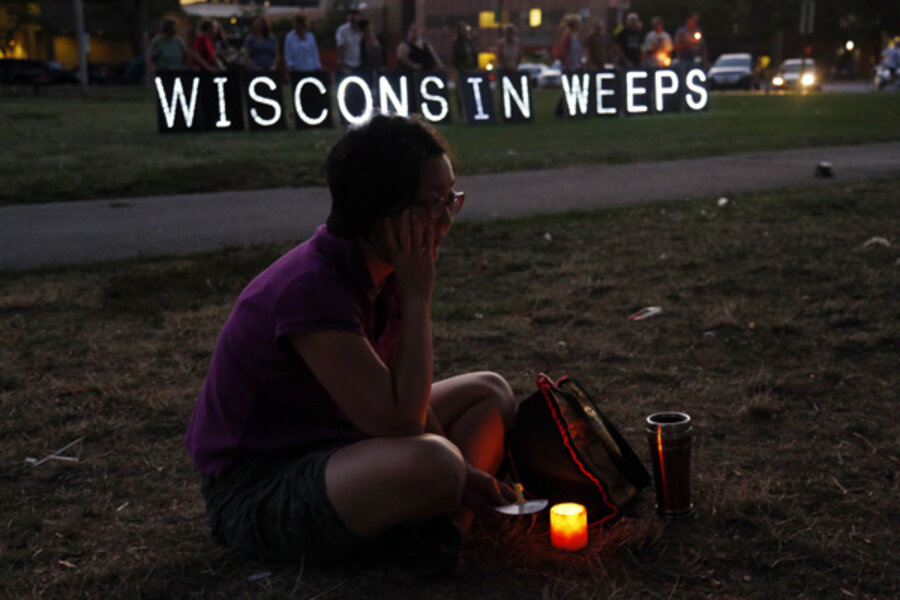Motive sought for mass shooting at Wis. Sikh temple
Loading...
| OAK CREEK, Wisconsin
Witnesses said the shooter who attacked a Sikh temple in the U.S. looked like he had a purpose and knew where he was going. Authorities on Monday scrambled to find a motive for the attack that left seven people, including the gunman, dead and three critically wounded. Police called it an act of domestic terrorism.
Terrified congregants ran for cover Sunday morning when the shooting began at the Sikh Temple of Wisconsin. The gunfire finally ended in a shootout between the gunman and police outside.
Satpal Kaleka, wife of the temple's president, Satwant Singh Kaleka, saw the gunman enter, according to Harpreet Singh, their nephew.
"He did not speak, he just began shooting," said Singh, relaying her description.
Worshippers said they had never seen the 6-foot (1.83-meter)-tall bald man at the temple before.
Federal authorities described the suspect as a white man in his 40s, but neither provided further details nor suggested a possible motive.
"We never thought this could happen to our community," said Devendar Nagra, 48, whose sister escaped injury by hiding as the gunman fired in the temple's kitchen. "We never did anything wrong to anyone."
Late Sunday, the investigation appeared to move beyond the temple as police, federal agents and the county sheriff's bomb squad swarmed a nearby neighborhood, evacuated several homes and searched a duplex. Bureau of Alcohol, Tobacco, Firearms and Explosives agent Tom Ahern said warrants were being served at the gunman's home. Residents were allowed to return Monday.
Oak Creek Police Chief John Edwards said police expected to release more information Monday. He said the FBI will lead the investigation because the shootings are being treated as domestic terrorism, or an attack that originated inside the U.S.
"While the FBI is investigating whether this matter might be an act of domestic terrorism, no motive has been determined at this time," Teresa Carlson, Special Agent in Charge with the agency's Milwaukee division, said in a statement Sunday night.
During a chaotic few hours after the first shots were fired around 10:30 a.m. (1430 GMT), police in tactical gear and carrying assault rifles surrounded the Sikh Temple of Wisconsin with armored vehicles and ambulances. Witnesses struggled with unrealized fears that several shooters were holding women and children hostage inside.
Edwards said the gunman "ambushed" one of the first officers to arrive at the temple as the officer tended to a victim outside. A second officer then exchanged gunfire with the suspect, who was fatally shot. Police had earlier said the officer who was shot killed the suspected shooter.
The wounded officer was in critical condition along with two other victims Sunday night, authorities said. Police said the officer was expected to survive.
Tactical units went through the temple and found four people dead inside and two outside, in addition to the shooter.
The Milwaukee County Medical Examiner's Office has received the bodies of the seven dead and autopsies will be conducted Monday morning, Medical Examiner spokeswoman Karen Domaglski.
Jatinder Mangat, 38, another nephew of the temple's president, said his uncle was among those shot, but he didn't know the extent of his injuries. When Mangat later learned people had died, he said "it was like the heart just sat down."
Gurpreet Kaur, 24, said her mother was among a group of about 14 other women preparing a meal in the temple kitchen when the gunman entered and started firing. Kaur said her mother felt two bullets fly by her as the group fled to the pantry. Her mother suffered what Kaur thought was shrapnel wound in her foot.
"These are people I've grown up with," she said. "They're like aunts and uncles to me. To see our community to go through something like this is numbing."
Many Sikhs in the U.S. worship on Sundays at a temple, or gurdwara, and a typical service consists of meditation and singing in a prayer room where worshippers remove their shoes and sit on the floor. Worshippers gather afterward for a meal that is open to the entire community.
Sikhism is a monotheistic faith founded more than 500 years ago in South Asia. It has roughly 27 million followers worldwide. Observant Sikhs do not cut their hair; male followers often cover their heads with turbans — which are considered sacred — and refrain from shaving their beards. There are roughly 500,000 Sikhs in the U.S., according to estimates. The majority worldwide live in India.
The Sikh Temple of Wisconsin started in 1997 with about 25 families. Construction on the current temple in Oak Creek began in 2006, according to the temple's website.
Sikh rights groups have reported a rise in bias attacks since the Sept. 11, 2001, terrorist attacks. The Washington-based Sikh Coalition has reported more than 700 incidents in the U.S. since 9/11, which advocates blame on anti-Islamic sentiment. Sikhs are not Muslims, but their long beards and turbans often cause them to be mistaken for Muslims, advocates say.
Police in New York and Chicago issued statements saying they were giving Sikh temples in those cities additional attention as a precaution.
Valarie Kaur, who chronicled violence against Sikh Americans in the 2006 documentary "Divided We Fall," said the shootings reopened wounds in a community whose members have found themselves frequent targets of hate-based attacks since Sept. 11.
"We are experiencing it as a hate crime," she said. "Every Sikh American today is hurting, grieving and afraid."







